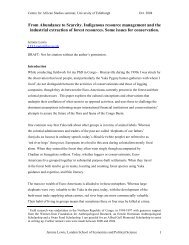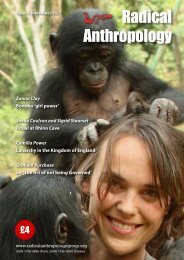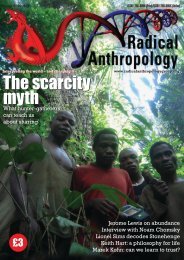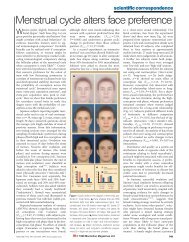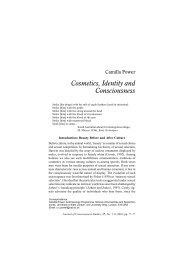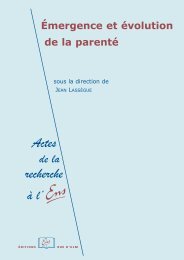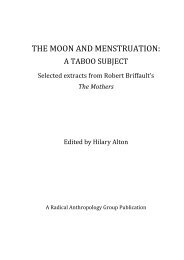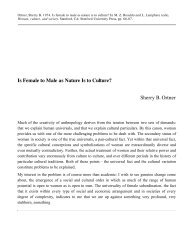Resp<strong>on</strong>se/Locke & Bogin: <str<strong>on</strong>g>Language</str<strong>on</strong>g> <str<strong>on</strong>g>and</str<strong>on</strong>g> <str<strong>on</strong>g>life</str<strong>on</strong>g> <str<strong>on</strong>g>history</str<strong>on</strong>g>performances of 3- to 5-year-old African American boyswere captured <strong>on</strong> audiotape <str<strong>on</strong>g>and</str<strong>on</strong>g> transcribed. In <strong>on</strong>e case,a sp<strong>on</strong>taneous rap, a boy expressed his feelings toward<strong>on</strong>e of <strong>the</strong> female research assistants <strong>on</strong> whom he haddeveloped a crush. In <strong>the</strong> o<strong>the</strong>r case, three boysengaged in “<strong>the</strong> dozens” (Wyatt 1995; 1999). These boyswere playing, but a decade later <strong>the</strong>y would be expectedto enlist <strong>the</strong>ir verbal abilities as adaptive strategies, <strong>on</strong>esthat would help <strong>the</strong>m to attract females, avoid violence,<str<strong>on</strong>g>and</str<strong>on</strong>g> compete for status with same-sex peers.To this point, we have exposed few c<strong>on</strong>necti<strong>on</strong>sbetween linguistic functi<strong>on</strong> <str<strong>on</strong>g>and</str<strong>on</strong>g> form, but if <strong>the</strong>re was areproductive advantage of vocal <str<strong>on</strong>g>and</str<strong>on</strong>g> verbal complexity,runaway selecti<strong>on</strong> – which, as Harvey <str<strong>on</strong>g>and</str<strong>on</strong>g> Arnold (1982)point out, would certainly have applied to vocalizati<strong>on</strong> –may have produced a huge increase in <strong>the</strong> complexity ofspeech <str<strong>on</strong>g>and</str<strong>on</strong>g>, <strong>the</strong>refore, <strong>the</strong> possibility of complexity ato<strong>the</strong>r levels of language, <str<strong>on</strong>g>and</str<strong>on</strong>g> possibly in o<strong>the</strong>r modalities.If speech were kept simple, observers would have to findo<strong>the</strong>r ways to make <strong>the</strong> necessary inferences.If a performance is rhythmic or euph<strong>on</strong>ious, <str<strong>on</strong>g>and</str<strong>on</strong>g> <strong>the</strong>material novel or complex, <strong>the</strong>n it is possible that form<str<strong>on</strong>g>and</str<strong>on</strong>g> functi<strong>on</strong> interact. Are <strong>the</strong>re relati<strong>on</strong>ships between<strong>the</strong> quality of <strong>the</strong> dance <str<strong>on</strong>g>and</str<strong>on</strong>g> <strong>the</strong> ornamentati<strong>on</strong> of <strong>the</strong>dancer? There are multiple cues to attractiveness ino<strong>the</strong>r species, <str<strong>on</strong>g>and</str<strong>on</strong>g> <strong>the</strong>se interact in extremely complexways to produce <strong>the</strong>ir effect (Badyaev & Hill 2003;C<str<strong>on</strong>g>and</str<strong>on</strong>g>olin 2003; van Doorn & Weissing 2004). They evencomplement each o<strong>the</strong>r (Badyaev et al. 2002; Colemanet al. 2004; Johns<strong>on</strong> 1999). In our own species, too, speakersare evaluated al<strong>on</strong>g with <strong>the</strong>ir messages. It is possiblethat in display mode, <strong>the</strong> evaluati<strong>on</strong>s of o<strong>the</strong>rs are basedboth <strong>on</strong> structural complexity <str<strong>on</strong>g>and</str<strong>on</strong>g> behavioral finesse.R6. Genetic support of verbal performanceWe have proposed that vocal <str<strong>on</strong>g>and</str<strong>on</strong>g> verbal skills enable adolescents<str<strong>on</strong>g>and</str<strong>on</strong>g> young adults to engage <str<strong>on</strong>g>and</str<strong>on</strong>g> compete witho<strong>the</strong>rs, <str<strong>on</strong>g>and</str<strong>on</strong>g> to perform in public arenas – <strong>the</strong> relevantabilities increasing <strong>the</strong>ir fitness. Now it could be saidthat <strong>the</strong>se verbal dimorphisms were merely brought to<strong>the</strong> surface <str<strong>on</strong>g>and</str<strong>on</strong>g> made observable by underlying sex differencesin <strong>the</strong> tendency to compete <str<strong>on</strong>g>and</str<strong>on</strong>g> aggress (Fitch 2005,p. 212). But, for behavioral traits, as opposed to physical<strong>on</strong>es that are readily perceptible, such as size, <strong>the</strong> individualmust be motivated to act in <strong>the</strong> first place, <str<strong>on</strong>g>and</str<strong>on</strong>g> <strong>the</strong>source of <strong>the</strong> motivati<strong>on</strong> may be an internal change. Infact, if anything was selected directly, it was vocal <str<strong>on</strong>g>and</str<strong>on</strong>g>verbal ability. The indirect effects were <strong>the</strong> supportingphysiological variables. Thus, males’ greater dispositi<strong>on</strong>to compete – sec<strong>on</strong>dary to increases in testoster<strong>on</strong>e –may have increased <strong>the</strong> functi<strong>on</strong>ality of <strong>the</strong>ir vocal <str<strong>on</strong>g>and</str<strong>on</strong>g>verbal ability while also making it public, raising <strong>the</strong> probabilitythat <strong>the</strong>se skills would be selected, <str<strong>on</strong>g>and</str<strong>on</strong>g> tightening<strong>the</strong> links between speech <str<strong>on</strong>g>and</str<strong>on</strong>g> testoster<strong>on</strong>e. If so, <strong>on</strong>emight expect a genetic legacy: genes that code specificallyfor verbal expressivity <str<strong>on</strong>g>and</str<strong>on</strong>g> dominance in modern humans.Recently we came across several reports indicating thatm<strong>on</strong>ozygotic twins, but not dizygotic twins, are highly c<strong>on</strong>cordant<strong>on</strong> measures of social potency <str<strong>on</strong>g>and</str<strong>on</strong>g> expressivec<strong>on</strong>trol, tests that tap <strong>the</strong> ability to act or perform insocial situati<strong>on</strong>s, even where <strong>the</strong> twins have been rearedapart (Gangestad & Simps<strong>on</strong> 1993; Lykken 1982).Significantly, individuals who were unusually social <str<strong>on</strong>g>and</str<strong>on</strong>g>expressive reported that <strong>the</strong>y had engaged in sex withmore partners, <str<strong>on</strong>g>and</str<strong>on</strong>g> with more partners <strong>on</strong> just <strong>on</strong>eoccasi<strong>on</strong>, than <strong>the</strong>ir less social <str<strong>on</strong>g>and</str<strong>on</strong>g> expressive peers(Snyder 1987).With such high c<strong>on</strong>cordance rates, <strong>on</strong>e might expect tosee differences in sociality <str<strong>on</strong>g>and</str<strong>on</strong>g> expressiveness appearingearly in <str<strong>on</strong>g>life</str<strong>on</strong>g> <str<strong>on</strong>g>history</str<strong>on</strong>g>. It is interesting, in this c<strong>on</strong>necti<strong>on</strong>,that investigators in o<strong>the</strong>r fields have documented <strong>the</strong>existence of unusually social <str<strong>on</strong>g>and</str<strong>on</strong>g> expressive individualsin infancy (cf. Nels<strong>on</strong> 1973; 1981), termed “dramatists”by Wolf <str<strong>on</strong>g>and</str<strong>on</strong>g> Gardner (1979) since <strong>the</strong>y appear to learnat an early age that different individuals can exchangeroles in identical social situati<strong>on</strong>s. Dramatists also like totell dramatic stories <str<strong>on</strong>g>and</str<strong>on</strong>g> display elaborate forms of imitati<strong>on</strong>.On <strong>the</strong> basis of c<strong>on</strong>tent validity, Gangestad <str<strong>on</strong>g>and</str<strong>on</strong>g>Snyder (1986) speculated that such expressive differencesin infancy <str<strong>on</strong>g>and</str<strong>on</strong>g> adulthood are manifestati<strong>on</strong>s of <strong>the</strong> samelatent factor.This secti<strong>on</strong> <strong>on</strong> <strong>the</strong> genetics of verbal performance is ac<strong>on</strong>venient place to acknowledge <strong>the</strong> kind remarks ofWorkman, who does, however, misinterpret our discussi<strong>on</strong>of FOXP2, thinking that we see in this gene a basisfor linguistic grammar. In fact, we referred to <strong>the</strong> behavioralresearch leading to <strong>the</strong> identificati<strong>on</strong> of this genebecause it related to <strong>the</strong> role in language that is playedby “producti<strong>on</strong> factors.” We pointed out that problemsexperienced by <strong>the</strong> KE family “included a severe oral<str<strong>on</strong>g>and</str<strong>on</strong>g> verbal dyspraxia, accompanied by deficits at o<strong>the</strong>rlevels of language” (emphasis added), <str<strong>on</strong>g>and</str<strong>on</strong>g> quoted fromseveral <strong>the</strong>orists who suggest that speech might have acertain primacy that has been neglected in <strong>the</strong> past. Thissupported our argument that verbal performance wasselected.R7. Performance as adaptati<strong>on</strong>What supported <strong>the</strong> use of vocal <str<strong>on</strong>g>and</str<strong>on</strong>g> speech-like activitybefore <strong>the</strong>re was speech? Knight & Power doubt ouraccount of reproductive advantages because, <strong>the</strong>y say, linguisticsigns represent no “cost” or investment. They fail torecognize several things. First, <strong>the</strong> resting metabolic rate(RMR) of <strong>the</strong> human brain exacts a c<strong>on</strong>tinuously highenergetic cost from infancy, as menti<strong>on</strong>ed in <strong>the</strong> targetarticle <str<strong>on</strong>g>and</str<strong>on</strong>g> in secti<strong>on</strong> R1. Were this not so, manycomplex human activities, including language, would beimpossible. Sec<strong>on</strong>d, articulated ph<strong>on</strong>ati<strong>on</strong> carries a greatdeal of informati<strong>on</strong> about <strong>the</strong> individual, whe<strong>the</strong>r or notit is c<strong>on</strong>sciously transmitted. Apes rely <strong>on</strong> this informati<strong>on</strong><str<strong>on</strong>g>and</str<strong>on</strong>g> so do we. Third, potentially informative comp<strong>on</strong>entsof <strong>the</strong> voice are supported by physiological activity thatis energetically expensive (e.g., pulm<strong>on</strong>ary pressure; cf.Fitch & Hauser 2002). Fourth, traits will be selected iffemales prefer <strong>the</strong>m, <str<strong>on</strong>g>and</str<strong>on</strong>g> not everything females preferis costly (Johns<strong>on</strong> 1999). Finally, <strong>the</strong> mere uttering ofcertain words (or o<strong>the</strong>r c<strong>on</strong>structi<strong>on</strong>s), especially rare<strong>on</strong>es, may reflect a great deal of prior learning – learningthat presupposes <strong>the</strong> efficient acti<strong>on</strong> of relevant mechanisms.Merely to use a behavior that was learned, orrequires an unusual mode of articulati<strong>on</strong>, can mean that<strong>the</strong> individual has an intact nervous system, has <strong>the</strong>ability to attend, perceive, store, retrieve, <str<strong>on</strong>g>and</str<strong>on</strong>g> reproducecomplex patterns of behavior, <str<strong>on</strong>g>and</str<strong>on</strong>g> can do so meaningfully310 BEHAVIORAL AND BRAIN SCIENCES (2006) 29:3
Resp<strong>on</strong>se/Locke & Bogin: <str<strong>on</strong>g>Language</str<strong>on</strong>g> <str<strong>on</strong>g>and</str<strong>on</strong>g> <str<strong>on</strong>g>life</str<strong>on</strong>g> <str<strong>on</strong>g>history</str<strong>on</strong>g>in an appropriate social c<strong>on</strong>text. The energetic requirementsof <strong>the</strong> motoric act, <str<strong>on</strong>g>and</str<strong>on</strong>g> <strong>the</strong> veracity of any statements,are not <strong>the</strong> <strong>on</strong>ly relevant factors.Dickins sees a need to identify proximate mechanismsfor <strong>the</strong> acti<strong>on</strong>s that we propose, <str<strong>on</strong>g>and</str<strong>on</strong>g> Powers would likeus to have made more explicit predicti<strong>on</strong>s. Perhaps weunderplayed our effort to c<strong>on</strong>struct an adaptive accountof vocalizati<strong>on</strong> in relati<strong>on</strong> to social dominance <str<strong>on</strong>g>and</str<strong>on</strong>g> courtship.In secti<strong>on</strong> 8, we suggested that women who areattracted to men with a comm<str<strong>on</strong>g>and</str<strong>on</strong>g>ing way of speakingmay get a mate for <strong>the</strong>mselves, <str<strong>on</strong>g>and</str<strong>on</strong>g> a fa<strong>the</strong>r for <strong>the</strong>ir children,who has high levels of testoster<strong>on</strong>e <str<strong>on</strong>g>and</str<strong>on</strong>g> status, <str<strong>on</strong>g>and</str<strong>on</strong>g>unusual access to valued resources. Specifically, we evaluatedresearch that reveals c<strong>on</strong>necti<strong>on</strong>s between propertiesof male voices, as measured acoustically <str<strong>on</strong>g>and</str<strong>on</strong>g> appraised perceptually,<str<strong>on</strong>g>and</str<strong>on</strong>g> both virility <str<strong>on</strong>g>and</str<strong>on</strong>g> social dominance. In light ofo<strong>the</strong>r research, we would predict that women prefer <strong>the</strong>voices of men who are high in testoster<strong>on</strong>e, especiallywhen heard during ovulati<strong>on</strong> (Fisher 2004; Puts 2005).In <strong>the</strong> target article we reviewed research indicating that<strong>the</strong> speech of courting men c<strong>on</strong>tains unusually wide frequency<str<strong>on</strong>g>and</str<strong>on</strong>g> intensity swings, <str<strong>on</strong>g>and</str<strong>on</strong>g> that young women,when asked to evaluate utterances extracted from children’sc<strong>on</strong>versati<strong>on</strong>s, expressed a preference for selecti<strong>on</strong>s thatwere classified as excitable, loud, <str<strong>on</strong>g>and</str<strong>on</strong>g> unc<strong>on</strong>trolled,am<strong>on</strong>g related variables. Taken toge<strong>the</strong>r, <strong>the</strong>se behaviorscould suggest <strong>the</strong> operati<strong>on</strong> of a sensory trap (after <strong>the</strong>pattern described in insects <str<strong>on</strong>g>and</str<strong>on</strong>g> o<strong>the</strong>r animals) in whichsexually mature males mimic <strong>the</strong> vocal qualities thatappear to excite females (Christy 1995; Enquist & Arak1993; Macias Garcia & Ramirez 2005). Surely <strong>the</strong>re is rawmaterial here for testable hypo<strong>the</strong>ses <strong>on</strong> <strong>the</strong> fitness benefitsnot just of speech, but of particular aspects of prosody, <str<strong>on</strong>g>and</str<strong>on</strong>g>investigati<strong>on</strong>s could easily be extended into lexical <str<strong>on</strong>g>and</str<strong>on</strong>g>o<strong>the</strong>r areas of spoken language. To implement such anagenda in <strong>the</strong> c<strong>on</strong>text of linguistic evoluti<strong>on</strong>, it will ofcourse be necessary to investigate <strong>the</strong> perceptual preferencesof sexually mature females <str<strong>on</strong>g>and</str<strong>on</strong>g> <strong>the</strong> use of male vocalizati<strong>on</strong><str<strong>on</strong>g>and</str<strong>on</strong>g> speech in social competiti<strong>on</strong> <str<strong>on</strong>g>and</str<strong>on</strong>g> courtship, <str<strong>on</strong>g>and</str<strong>on</strong>g>this is exactly <strong>the</strong> kind of research that we propose. In li<str<strong>on</strong>g>new</str<strong>on</strong>g>ith a st<str<strong>on</strong>g>and</str<strong>on</strong>g>ard approach in biology, it would <strong>the</strong>n be possibleto look at which vocal variables were most str<strong>on</strong>glylinked to percepti<strong>on</strong>s <str<strong>on</strong>g>and</str<strong>on</strong>g> proximate variables that indexfitness. By carrying out a research agenda of this sort, <strong>on</strong>edoes not show how language evolved, of course, but <strong>on</strong>emay be able to argue for <strong>the</strong> plausibility of a particularproposal <strong>on</strong> <strong>the</strong> basis of empirical data.Dickins is not sure that we adequately supported ourclaim that <strong>the</strong> comp<strong>on</strong>ents of language are related, but itcan <strong>on</strong>ly be so if, as we argued in <strong>the</strong> target article <str<strong>on</strong>g>and</str<strong>on</strong>g>repeated earlier in this resp<strong>on</strong>se (sect. R3), <strong>the</strong>y werestitched toge<strong>the</strong>r by sequential patterns of selecti<strong>on</strong>. Behaviorsthat were selected at sexual maturity, such as verbalpersuasiveness, could not have appeared without somelevel of pragmatic <strong>development</strong>, <str<strong>on</strong>g>and</str<strong>on</strong>g> without linguisticskills that rest <strong>on</strong> previous accomplishments in <strong>the</strong> areaof lexical, ph<strong>on</strong>ological, morphological, <str<strong>on</strong>g>and</str<strong>on</strong>g> syntactic<strong>development</strong>. We noted in this c<strong>on</strong>text, additi<strong>on</strong>ally, <strong>the</strong>well-attested observati<strong>on</strong> that <strong>development</strong> is c<strong>on</strong>tinuous,behaviors not usually emerging de novo in later <strong>on</strong>togeneticstages without an appearance, in some form, in <strong>on</strong>eor more of <strong>the</strong> preceding <strong>on</strong>es. We also cited evidencesuggesting that individuals having problems in <strong>on</strong>e areaof language tend to have problems in o<strong>the</strong>r areas.Johanss<strong>on</strong> et al. say that we failed to show “thatlanguage was useful <str<strong>on</strong>g>and</str<strong>on</strong>g> adaptive specifically for protohumans<str<strong>on</strong>g>and</str<strong>on</strong>g> not for proto-chimpanzees.” Ragir &Brooks seem to think, in parallel, that if language benefitshumans, it should have benefited <strong>the</strong> o<strong>the</strong>r primatesequally. If it did, <strong>the</strong>y say, <strong>the</strong> behavior would have followed.But <strong>the</strong>se comments miss <strong>the</strong> point. The questi<strong>on</strong>is not who language could have assisted, but ra<strong>the</strong>r, inwhom it could have evolved. In secti<strong>on</strong> R1, we point outthat hominins took a different path, <strong>on</strong>e that led to cooperativebreeding <str<strong>on</strong>g>and</str<strong>on</strong>g> protolanguage, <str<strong>on</strong>g>and</str<strong>on</strong>g> <strong>the</strong>reforeevolved a completely different <str<strong>on</strong>g>life</str<strong>on</strong>g> <str<strong>on</strong>g>history</str<strong>on</strong>g>.Ragir & Brooks comment that performance is beneficialat every stage of language <strong>development</strong>, not justin adolescence. That we also believe this is why wedevoted so much attenti<strong>on</strong> to proposals regarding infantbehavior, including parental selecti<strong>on</strong> <str<strong>on</strong>g>and</str<strong>on</strong>g> trickle-up ph<strong>on</strong>etics.In <strong>the</strong> target article, we argued that skillful vocalperformances by adolescent <str<strong>on</strong>g>and</str<strong>on</strong>g> adult male homininswould have facilitated <strong>the</strong>ir quest for rank <str<strong>on</strong>g>and</str<strong>on</strong>g> reproducti<strong>on</strong>.Ragir & Brooks express doubt about a porti<strong>on</strong> ofthis argument since, <strong>the</strong>y say, female apes fail to show apreference for alpha males. The relevance of this isunclear, since our claim is that <strong>the</strong>re were changes inhominins that occurred following <strong>the</strong>ir divergence fromshared lineage. As indicated in <strong>the</strong> target article, wetrace <strong>the</strong>se changes to pre-adult stages when c<strong>on</strong>trolover <str<strong>on</strong>g>new</str<strong>on</strong>g> <str<strong>on</strong>g>and</str<strong>on</strong>g> more variegated vocal behaviors emergedunder envir<strong>on</strong>mental pressures that remodeled humaninfancy <str<strong>on</strong>g>and</str<strong>on</strong>g> c<strong>on</strong>tributed to <strong>the</strong> evoluti<strong>on</strong> of childhood.R8. PluralismWe noted at <strong>the</strong> beginning of secti<strong>on</strong> R2 that in <strong>the</strong> first stageof evoluti<strong>on</strong>, envir<strong>on</strong>mental variati<strong>on</strong> produces novel formsthat vary genetically, <str<strong>on</strong>g>and</str<strong>on</strong>g> that in <strong>the</strong> sec<strong>on</strong>d stage of evoluti<strong>on</strong>,selecti<strong>on</strong> acts <strong>on</strong> <strong>the</strong> variants. According to ouraccount, infancy <str<strong>on</strong>g>and</str<strong>on</strong>g> childhood produced <str<strong>on</strong>g>new</str<strong>on</strong>g> abilities toeffect <str<strong>on</strong>g>and</str<strong>on</strong>g> manipulate vocal forms, with selecti<strong>on</strong> occurringin those stages <str<strong>on</strong>g>and</str<strong>on</strong>g> perhaps more powerfully at sexual maturity.To us, <strong>the</strong> <strong>development</strong> <str<strong>on</strong>g>and</str<strong>on</strong>g> evoluti<strong>on</strong> of language – <str<strong>on</strong>g>and</str<strong>on</strong>g>ultimately its nature – are interrelated. Work in <strong>on</strong>e areapotentially affects progress in <strong>the</strong> o<strong>the</strong>r. Theorists mustintegrate findings in psychology, biology, animal behavior,anthropology, archaeology, genetics, <str<strong>on</strong>g>and</str<strong>on</strong>g> linguistics if<strong>the</strong>se benefits are to be appreciated. In our own attemptto explain <strong>the</strong> evoluti<strong>on</strong> <str<strong>on</strong>g>and</str<strong>on</strong>g> modificati<strong>on</strong> of <str<strong>on</strong>g>life</str<strong>on</strong>g> <str<strong>on</strong>g>history</str<strong>on</strong>g>stages, we needed to integrate findings from archaeologywith findings <strong>on</strong> <strong>the</strong> <strong>development</strong> of brains, teeth, endocrinesystems, <str<strong>on</strong>g>and</str<strong>on</strong>g> o<strong>the</strong>r characteristics of modern humans. Wethink that such efforts will eventually produce a small steptoward <strong>the</strong> unificati<strong>on</strong> of a broad base of language-relevantknowledge, emanating from a wide range of disciplines.Theorists also need to explain <strong>development</strong>s across <strong>the</strong>various stages of linguistic evoluti<strong>on</strong>, not merely thosepertaining to language as it is, or as it appears, now. Wehave claimed that inserti<strong>on</strong> of <str<strong>on</strong>g>new</str<strong>on</strong>g> <strong>on</strong>togenetic stages intohuman <str<strong>on</strong>g>life</str<strong>on</strong>g> <str<strong>on</strong>g>history</str<strong>on</strong>g>, <str<strong>on</strong>g>and</str<strong>on</strong>g> <strong>the</strong> remodeling of o<strong>the</strong>rs, produced<str<strong>on</strong>g>new</str<strong>on</strong>g> <strong>development</strong>al processes that fashi<strong>on</strong>ed novelcommunicative behaviors <str<strong>on</strong>g>and</str<strong>on</strong>g> increased fitness. If so,reciprocal acti<strong>on</strong> by evoluti<strong>on</strong>ary <str<strong>on</strong>g>and</str<strong>on</strong>g> <strong>development</strong>almechanisms – working in an “evo-devo-evo” sequence –may have played a major role in <strong>the</strong> evoluti<strong>on</strong> of language.BEHAVIORAL AND BRAIN SCIENCES (2006) 29:3 311



